- The Herb Guide Home
- Growers Dictionary
- Perennial Herbs
Perennial Herbs
As an Amazon Associate I earn from qualifying purchases
Perennial Herbs as a framework for your garden
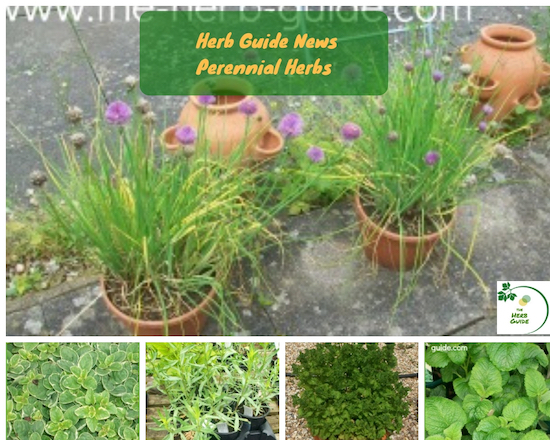
Perennial herbs make a great framework for your herb garden - they're the gift that keeps on giving!
They are the ones that you plant once and they come up year after year - annuals (eg basil) you sow and they germinate and die in the same year, biennial (eg parsley) sow one year, they germinate that year, flower the next and then die.
The basic cycle for a perennial plant is to have a dormant season (in the case of these herbs, that's normally winter) emerge in the spring, grow through the summer into the fall (autumn) and the top growth then dies back to start again the following year.
They are good value herbs, but you need to position them carefully when you first plant them. Have a mind to how tall they grow and what aspect they need - whether it's shade, full sun, partial shade, protection from frost, wind etc.
Consider also if they will spread and leave space between them when you first put them into the ground. They'll soon fill out as they mature.
You don't have to grow them all - just look at the list and see which ones you use regularly, perhaps plant a couple you'd like to try and bear in mind the bees - go for some plants that will attract the pollinators as your whole garden will benefit from that.
The other herb category is shrubby herbs - things like bay, sage, rosemary and thyme which are mainly evergreen and also contribute to the 'framework'.
Below is a list of the most common culinary perennial herbs and some brief details. For more information on each herb, click the highlighted link in each entry to go through to the 'growing' page.

You can try a sample lesson to help you decide if the Herbal Academy of New England is the right choice for you - follow the link below.
Chives
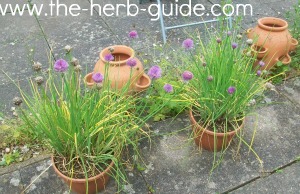
Chives are one of my favourite perennial herbs - they have a delicate onion flavour and grow the most beautiful purple globe flowers in the summer. They grow around 6 to 12 inches high in clumps.
They are highly attractive to bees and other pollinators.
They're a tremendous plant to put into pots or use as an edging around a border - doesn't have to be the herb garden, as they'll look just as good round a flower border or use them in your vegetable or fruit garden to help attract pollinators.
I love them snipped into scrambled eggs, omelettes and potato salad. I like to sprinkle some over vegetable soups too.
Fennel
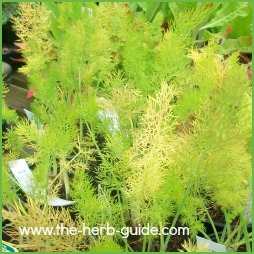
Fennel is a feathery plant, it grows quite tall (up to five feet) so would need to be towards the rear of your herb garden. For that reason, you would perhaps need to stake it with a cane to give it some support.
It has a mild aniseed flavour and goes well with pork, fish and eggs.
It's been historically used as a remedy for flatulence and is a constituent of baby's gripe water.
It's a relative of the annual, dill - don't plant them near each other as they might cross pollinate and you'd get a weird hybrid.
Horseradish
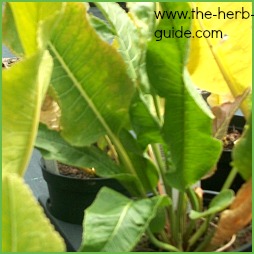
Fiery hot horseradish - it looks a bit like dock leaves but if you notice, there is a wavy edge to the leaf and it's tall and thin proportionally.
You use the roots to make horseradish sauce which goes perfectly with beef and oily fish such as smoked mackerel. Grate it finely and sprinkle a little on avocado or chopped eggs mixed with mayonnaise for a sandwich filling.
It is extremely invasive - the long tap roots can break off as you harvest it and you can end up with a huge bed of it. Be ruthless and dig up what you don't need. You can sow the small pieces in pots and give them away to friends!
Lemon Balm
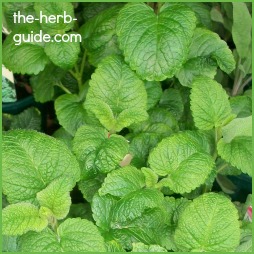
Lemon Balm grows to about 2 feet tall. It has deep green fleshy leaves.
It is useful in cooking - use it generously as it becomes less 'lemony' once it is heated up. Good with fish dishes, in milk puddings, cakes and summery drinks.
It is highly attractive to bees and its common name is 'bee balm'. Be sure to have some in your garden as it will attract the pollinators which will be of enormous help to growing vegetables etc.
Marjoram - Pot
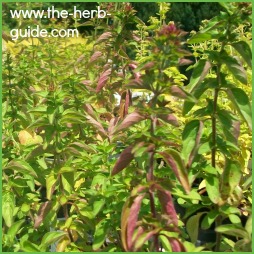
Pot Marjoram grows to around 2 feet tall and likes a warm sunny spot.
It's not to be confused with Sweet Marjoram, which is an annual.
It grows by throwing out runners, much like mint and needs to be kept under control. The two of them are the thugs of the herb garden!
It's very useful though, going with most meats and dishes with tomatoes, mushrooms or pulses.
Marjoram - Wild - Oregano
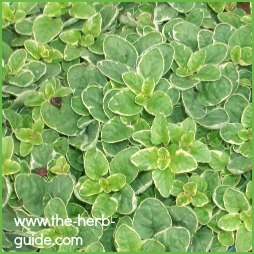
Wild Marjoram is more commonly referred to as Oregano and is a favourite in Mediterranean dishes. Perfect with tomatoes, pasta and the like.
It grows to about 2 feet in height but will sprawl, so it's a bit untidy and will need clipping back. Use it generously in cooking and pull up the bits you don't want, pot them on and give them to your friends.
Mint
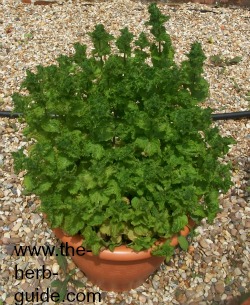
Mint is an absolute thug when it comes to the herb garden. There are around 600 different varieties but none of them keep themselves to themselves. although some of them are really small to start with.
They spread out runners and will appear where you least expect them. The best way to grow mint is as above, in a large pot, which you then pick up and move every so often so that the roots don't shoot out of the bottom into the soil.
On the plus side, it's a lovely, fragrant herb and bees are attracted to its flowers.
You can use it with lamb, in potatoes and other vegetable dishes and of course, crushed leaves in your summer drinks.
Sorrel
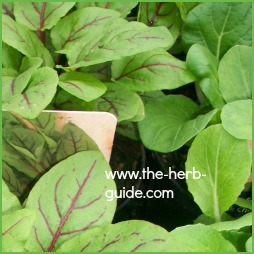
Sorrel is a beautiful plant and sorrel sauce is a classic with fish. The leaves can be used as a substitute for watercress or spinach in cooked dishes and sorrel makes a wonderful soup.
It does have a lemony, sour taste, so give it a small try to see if you like it.
It grows to about two feet high and has a reddish tinge to the dark green leaves.
Tarragon
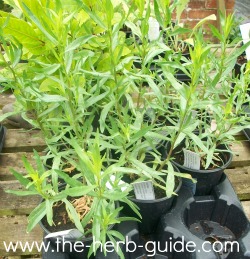
Tarragon grows around two feet high and has elegant, pointed mid green leaves.
It likes a sunny but sheltered spot, so is good for the back of your herb garden, where it can be protected either by a wall or other plants.
It's good with steaks, mushrooms, omelettes, grilled fish and for flavouring vinegars. Try making some herb butter to add to plainly cooked meat or fish.
How to overwinter Perennial Herbs
Basically, you don't overwinter perennial herbs - not the ones that have been growing in your garden anyway.
Perennial herbs have a growing season - they die down in the winter and come back in the spring. It's their rest time and they need it in much the same way as you need to sleep every night.
A way you can have fresh perennial herbs indoors over the winter is to take a few cuttings towards the end of the season and root them in soil. Then you can use them over the winter.
Come the spring when your herbs have come back to life in the garden, you can plant out the ones that you've been using over the winter and let them do what comes naturally. They will most likely fall into their natural rhythm along with their mates over the following twelve months.
I may receive a commission if you purchase something mentioned in this post. See more details here This will not affect the amount you pay.

